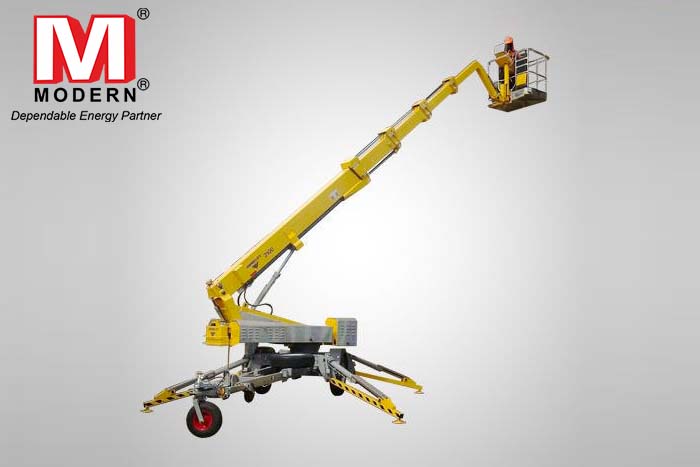Working at height often presents complex challenges—limited access, uneven terrain, or confined spaces. This is where spider booms come into play. Also known as tracked boom lifts or compact lift platforms, these machines offer a unique combination of reach, stability, and manoeuvrability, making them indispensable across construction, maintenance, arboriculture, and industrial cleaning in New Zealand.
If you’re exploring equipment options for elevated tasks, understanding how spider booms work—and when to use them—can save you time, reduce risk, and improve productivity.
What Are Spider Booms?S
A spider boom is a type of articulated boom lift equipped with extendable legs (outriggers) and rubber tracks. Its name derives from the leg-like supports that stabilize the machine on uneven ground. The unit’s compact body allows it to pass through tight doorways, while its hydraulic arm can extend vertically and horizontally to access hard-to-reach areas.
Unlike traditional boom lifts or scissor lifts, spider booms are designed for versatility, offering precise height access in environments where space or terrain would typically be a constraint.
Why Spider Booms Are Gaining Popularity in NZ
1. Compact Size, Big Reach
Spider booms are designed to operate in confined areas without sacrificing height or outreach. They can fit through single or double doors, navigate narrow pathways, and still offer up to 30 metres of vertical reach—ideal for urban sites or interior maintenance work.
2. Adaptability on Uneven Terrain
Their adjustable outriggers make spider booms particularly effective on sloped, soft, or unstable ground—common on many New Zealand job sites. Whether you’re working on a steep driveway, over landscaping, or inside a heritage building, spider booms offer a level base and operational stability.
3. Lightweight and Low Impact
Compared to other access platforms, spider booms have a low gross weight, which reduces the risk of damaging floors or delicate surfaces. This makes them perfect for indoor applications or working on lawns, tiles, and paved areas where surface protection is essential.
Common Applications Across New Zealand
Spider booms are widely used across various sectors, including:
- Building Maintenance: Cleaning windows, repairing facades, or painting high walls
- Tree Work: Trimming or removing trees in difficult locations
- Construction: Accessing structural components or installing signage in tight urban settings
- Facility Management: Indoor ceiling work, such as electrical, HVAC, or sprinkler maintenance
In each case, spider booms provide safe, precise access with minimal disruption to surroundings.
Best Practices When Hiring or Using a Spider Boom
Conduct a Site Assessment First
Before selecting a spider boom, assess your worksite conditions:
- Are there narrow access points?
- Is the ground level or sloped?
- Will the work be done indoors or outdoors?
- What is the required working height and horizontal outreach?
Answering these questions will help you choose the right model for the job.
Ensure Proper Training and Certification
Operating a spider boom requires specific skills. In New Zealand, users must hold an EWP (Elevated Work Platform) Operator Certificate aligned with WorkSafe NZ guidelines. Ensure that all operators are trained to handle not only the boom’s movement but also safety checks, load limits, and emergency procedures.
Plan for Setup and Stability
Use the outriggers correctly, placing pads or base plates beneath the legs if working on soft or uneven surfaces. Always check for overhead hazards such as power lines or tree branches, and secure the work area to prevent unauthorised access.
Hiring Spider Booms in NZ: What to Look For
Not all spider boom lifts are created equal. When hiring, consider factors like:
- Maximum platform height and outreach
- Weight of the machine and load capacity
- Power source (diesel, electric, or hybrid)
- Indoor vs. outdoor suitability
- Remote control operation and driveability
Safety and Compliance in the NZ Context
New Zealand has strict health and safety standards under the Health and Safety at Work Act 2015 (HSWA). Employers and contractors must ensure that all elevated work is carried out with approved equipment, trained personnel, and appropriate risk assessments.
Spider booms, when properly used, help meet these obligations by offering secure, stable access for elevated tasks that might otherwise pose safety concerns.
Final Word: When to Choose Spider Booms
When you need to access heights in complex, restricted, or sensitive environments, spider booms are often the most efficient and safest option. Their flexibility, compactness, and terrain adaptability make them suitable for both short-term maintenance and long-term construction projects.
Whether you’re a property manager maintaining a multi-storey building or a contractor working on sloped residential blocks, spider booms are a smart choice for getting the job done right—without compromise on safety or performance.




